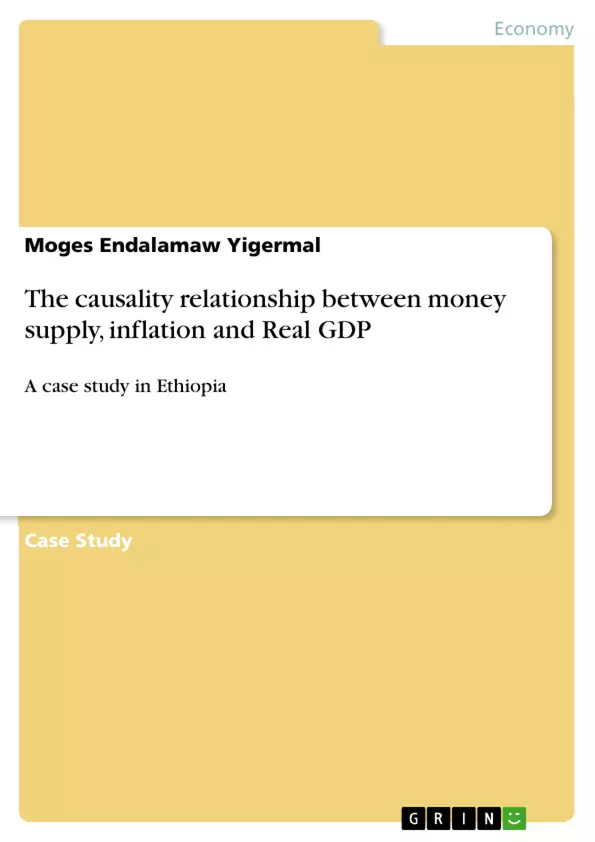Since the main objective of the paper is to test the existence of causality relationship between the three macroeconomic variables, namely real GDP, price level (CPI) and M2 money supply (MS), analysis has been made there by employing 40 years of data (data from 1975-2014). VAR Granger causality test has been made to verify the objective of the paper.
The VAR Granger causality test result suggesting the existence of strong and significant correlation between the three variable s pairwise. The direction of causation is found to be a uni- directional causation between money supply and inflation, real GDP and Money supply and between real GDP and inflation and the causation runs from money supply to inflation, real GDP to Money supply and real GDP to inflation respectively. From the causation we observed that money supply has relationship with level of price and economic growth (real GDP). Basically targeting monetary expansion has a multiple role to boost economic growth and control the level of inflation.
Inhaltsverzeichnis (Table of Contents)
- Abstract
- I. Introduction
- 1.1. Back ground of the study
- 1.2. Statement of the Problem
- 1.3. Objective of the study
- 1.4. Scope of the study
- 1.5. Organization of the paper
- 2. Literature Review
- 2.1 Theoretical Literature Review
- 2.2. Empirical Literature Review
- 3. Research methodology
- 3. 1. Source and type data
- 3.2. Method of data analysis
- 3.3. Model specification
- 4. Empirical Result and discussion
- 4.1. Tests for Stationary, Unit root test (ADF)
- 4.2. VAR lag order selection criteria
- 4.3.VAR Granger causality result
- 4.4. Wald test result results
- 5. Policy Implication and Recommendation
- Reference
Zielsetzung und Themenschwerpunkte (Objectives and Key Themes)
The primary objective of this paper is to analyze the causal relationship between three key macroeconomic variables in Ethiopia: real GDP, price level (CPI), and M2 money supply (MS). Using 40 years of data from 1975 to 2014, the paper utilizes the VAR Granger causality test to investigate the direction and strength of these causal connections.
- The causal relationship between money supply, inflation, and real GDP in Ethiopia
- The role of monetary policy in controlling inflation and boosting economic growth
- The impact of money supply on the price level and economic output
- The application of the VAR Granger causality test to analyze macroeconomic data
- The implications of the study's findings for economic policy in Ethiopia
Zusammenfassung der Kapitel (Chapter Summaries)
- Chapter I: Introduction This chapter introduces the study by providing background information, outlining the problem, stating the objectives, defining the scope, and outlining the paper's organization.
- Chapter 2: Literature Review This chapter presents a comprehensive review of both theoretical and empirical literature related to the causal relationship between money supply, inflation, and real GDP. It explores different economic schools of thought and examines previous studies on this topic, particularly focusing on Ethiopia and similar economies.
- Chapter 3: Research Methodology This chapter describes the research methodology used in the study. It details the data sources, the type of data used, the methods of data analysis employed, and the model specification. It also explains the rationale behind the chosen methods and the process of data collection and preparation.
- Chapter 4: Empirical Result and Discussion This chapter presents and discusses the empirical results obtained from the analysis. It includes the results of tests for stationarity, unit root test (ADF), VAR lag order selection criteria, VAR Granger causality test, and Wald test results. The chapter analyzes and interprets these results, drawing insights into the causal relationship between the three macroeconomic variables.
Schlüsselwörter (Keywords)
The study revolves around the key concepts of VAR Granger causality, macroeconomic variables, money supply, inflation, and real GDP, with a focus on their interrelationships within the Ethiopian context. It delves into the impact of monetary policy, particularly money supply, on inflation and economic growth, utilizing empirical data analysis to understand the direction and strength of causality between these variables.
- Arbeit zitieren
- Moges Endalamaw Yigermal (Autor:in), 2016, The causality relationship between money supply, inflation and Real GDP, München, GRIN Verlag, https://www.grin.com/document/414627



